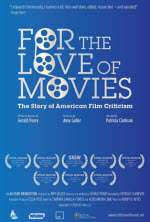Review and Panel: For the Love of Movies
 An unsettling aspect of Gerald Peary's 2009 documentary For the Love of Movies: The Story of American Film Criticism is that so many of the critics interviewed are identified as "ex-critics" of print media such as The New York Times.
An unsettling aspect of Gerald Peary's 2009 documentary For the Love of Movies: The Story of American Film Criticism is that so many of the critics interviewed are identified as "ex-critics" of print media such as The New York Times.
Yeah, things aren't so rosy for film critics these days, at least for critics seeking paychecks from traditional newspapers and magazines. Film criticism jobs are disappearing as fast as the classified advertising that once funded them. In the face of falling revenues and online competition, periodicals are jettisoning everything from foreign news bureaus to op-ed columnists to local arts coverage.
But all is not hopeless, as For the Love of Movies tells us. Film critics are adapting to the brave new media world, and as long they remain passionate about movies, the century-old tradition of reviewing them will continue.
The future of film criticism was no doubt on everyone's mind at a February 10 screening of For the Love of Movies presented by the Austin Film Society at the Alamo Drafthouse on South Lamar. Peary was in attendance for a brief post-screening Q&A, followed by a panel discussion moderated by UT professor Thomas Schatz and featuring local critics Marjorie Baumgarten of the Austin Chronicle, Charles Ealy of the Austin American Statesman, Slackerwood's own Jette Kernion, and Austin Film Critics Association founder and president Cole Dabney.
For the Love of Movies is informative and provocative, the sort of documentary that inspires post-viewing coffeehouse discussions. (Note: For film critics, those discussions may be more likely to happen in bars.) Peary's micro-budget film is part history lesson, part examination of the art and practice of film criticism and part lament over the profession's current state. The film combines the expected talking heads with an eclectic mix of film footage, along with photos and film clips of notable critics from the past and voiceover readings from their reviews.
There is plenty of interesting material in For the Love of Movies, from decades-old footage of Pauline Kael to a discussion of the auteur theory to glimpses of Gene Siskel with a full head of hair. The film's strongest suit is its overview of criticism's evolution from its early 20th century nascence to its current online incarnations. More than just a timeline, the overview also compares and contrasts the styles of revered critics such as the brash, antiestablishment Kael and the much more traditional and moralistic Bosley Crowther. The comments from current critics such as Roger Ebert and A.O. Scott also are insightful, if not quite revelatory.
For the Love of Movies suffers, however, from trying to cover too much material in too little time. In 80 minutes, it attempts to explain the nature, history and current state of film criticism, as well as speculate about its future, and thus barely scratches the surface of these complex and disparate topics.
The historical overview is entertaining and informative, but it devotes a scant few minutes to each historical period, without going into much detail or giving influential critics their due. The many interviews with modern critics are too short also; some are little more than longish sound bites. Again, many of them are insightful and amusing, but they don't quite add up to a meaningful examination of what it's like to be a film critic. The final act of For the Love of Movies also feels hurried; it barely touches on the role of film criticism in today's digital media world and doesn't tie together the film's other content into a coherent message about the profession's future.
For the Love of Movies also feels slightly disjointed, with some jarring transitions and an uneven look. Some of these problems probably are unavoidable, as For the Love of Movies is an assemblage of interviews conducted over several years and archival footage from the 1900s through the 1990s. But the film lacks the polish and editing finesse of other equally low-budget documentaries I've seen lately, such as Winnebago Man and 9500 Liberty.
That said, I found For the Love of Movies interesting enough to recommend to anyone wanting to learn more about film criticism. It lacks artistry and depth, but is a useful primer and starting point for more research about the profession.
In the Q&A, Peary discussed his difficulties in making the film, including its nine-year gestation and a budget that greatly limited the running time and content. When asked if any critics refused to be interviewed, he said that most were very cooperative. But the adamantly camera-shy Manohla Dargis tentatively agreed only to an audio interview, which wouldn't have worked in the film.
Not surprisingly, the critics in the post-screening panel discussion had plenty to say about their profession. Most of the discussion centered on old-vs.-new media and the changing roles critics must play to remain relevant and, hopefully, employed.
Ealy said that newspapers now expect critics to be reporters also, covering local film-related events and industry news. Also, he and Baumgarten said that in addition to writing traditional reviews, newspaper critics now are expected to blog regularly and reach younger readers through Twitter and Facebook. They said that many veteran critics are reluctant to do so, not because they're averse to new technology, but because the blogging, tweeting, and Facebook posting amount to unpaid work.
The panelists varied widely in age. Despite his years of experience, Dabney is an early twentysomething; I wouldn't dare speculate on the others' ages, except to say that they're at least a generation ahead of Dabney. But they all seemed to agree that a critic's age really is irrelevant, especially in an age when teenage bloggers compete with critics old enough to be their grandparents. What really matters is writing ability, an understanding of how films are made and an appreciation of what makes a film great, so-so or deserving of a scathing review. And of course, above all else a critic must love movies and have passionate opinions about them.
None of the panelists denied that the profession is suffering through hard times. As Ealy said, the days of long-form criticism are all but gone, giving way to Twitter-hyped, blog entry-length reviews with little background information or broader context. And criticism as a vocation also is diminishing; many local papers no longer employ their own critics, relying instead on syndicated reviews from nationally known names like Ebert.
But despite these disheartening trends, the panelists generally were optimistic, noting that while many critics have been laid off from traditional media outlets, they're hardly "ex-critics." They're now publishing reviews on their own blogs, free from the constraints of their former employers (and in some cases, earning an income from their websites). If the panelists agreed on anything, it's that film criticism is alive and well, albeit in new forms. As it has done to the rest of our culture, the Internet has greatly democratized film criticism by allowing many more voices to be heard. As Ealy said, "It's all a good thing."
If you want to see For the Love of Movies, it's available on DVD through the film's website.


long-form criticism has moved online
I didn't have time to say this during the panel, but I disagree with Charles Ealy's claim that long-form criticism is dead. Maybe that's true in print, and certainly in newspapers, but there are some great websites online that do wonderful extended critical pieces about movies. The Self-Styled Siren, for example, not only does this kind of writing all the time but co-sponsors a Film Noir blog-a-thon (going on right now) that is encouraging all kinds of critical writing about that genre. I could find you a dozen other excellent sites like this quite easily.